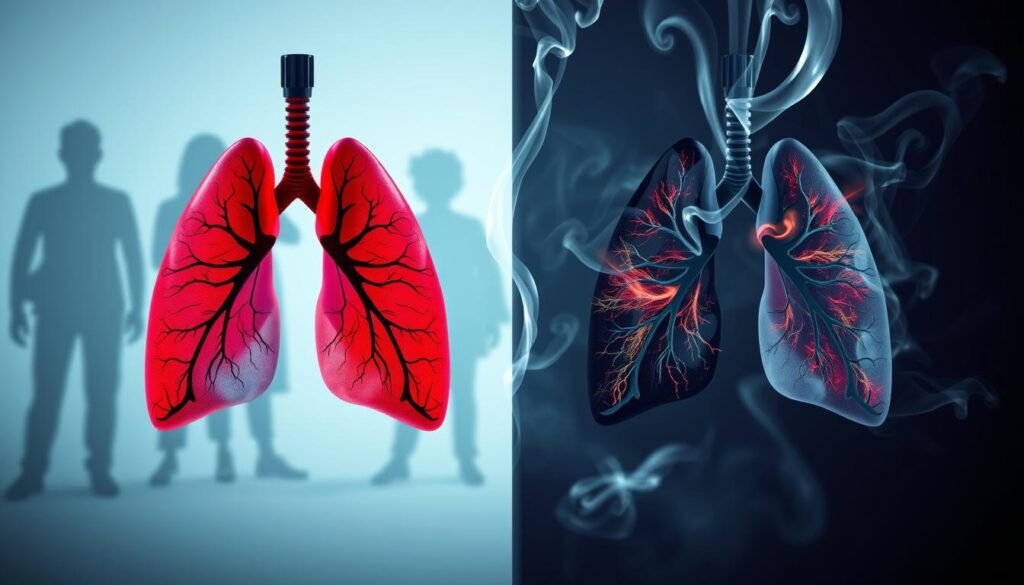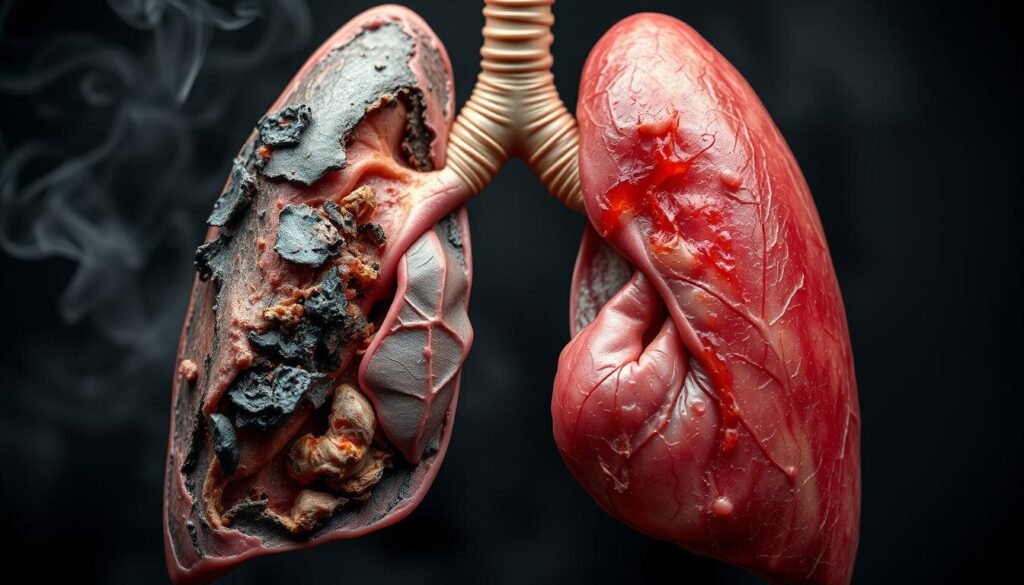Did you know smoking leads to about 480,000 deaths yearly in the US? It highlights why we must understand the role of age and smoking duration on health risks after quitting. Smoking is a major cause of preventable diseases. It harms nearly every organ, causing lung cancer, heart disease, and COPD.
How long a person has smoked significantly affects their health risks. Starting to smoke early can lead to higher death rates as an adult. However, quitting before turning 30 can avoid many dangers. It puts individuals on a path to better health in the long term. Knowing how age and smoking duration affect health is crucial for stopping smoking effectively.
The link between smoking, its start age, and how long people smoke is important. We need to focus on stopping smoking early. That way, we can fight the huge negative effects of smoking on public health.
Key Takeaways
- Smoking is the top cause of preventable disease and early death in the U.S.
- Quitting before age 30 greatly reduces the risk of dying compared to those who keep smoking.
- The longer someone smokes, the higher their chance of chronic diseases.
- Stopping smoking early is key to avoiding the severe risk of lung cancer from long-term smoking.
- Knewing about smoking’s health effects is critical to make effective anti-smoking programs.
Introduction to Post-Smoking Risks
After people quit smoking, they still face health challenges. Many have issues because of how long and how much they smoked. More than 16 million Americans have diseases from smoking. This shows how big the problem is. Every year, smoking and the smoke others breathe in cause over 480,000 deaths in the U.S. This makes smoking a top reason for death related to smoking.
People who stop smoking can still get sick. They might have long-lasting lung problems or heart issues. Indeed, more than 73% of smokers’ diseases are lung-related. Knowing these risks is important. It can motivate someone to stay away from cigarettes for good.
Being around smoke is also dangerous. It leads to over 40,000 nonsmokers dying each year. Even worse, 400 babies die because of it. If kids breathe in smoke, they get sick more easily. But quitting smoking at any age helps. It cuts the risk of dying young and getting smoking-related illnesses.
| Post-Smoking Risks | Statistics |
|---|---|
| People with smoking-related diseases | 16 million |
| Annual deaths due to smoking and secondhand smoke | 480,000+ |
| Chronic lung diseases in current smokers | 73% |
| Deaths from secondhand smoke among adults | 40,000 |
| Deaths from secondhand smoke in infants | 400 |
The Impact of Smoking Duration on Health
Research shows that duration of smoking is key to understanding its effects on health. Smoking for many years mainly leads to respiratory diseases and cancer. The risk for lung cancer rises with each added year of smoking.
The pack-years concept combines smoking intensity and time. Yet, the total time spent smoking is a bigger risk factor. It doesn’t matter as much how many cigarettes one smokes a day.
People who smoke for a long time face a higher risk of lung cancer. They are also more likely to get obstructive lung diseases, like COPD. Smoking for years harms lung function more than the number of cigarettes smoked.
Quitting smoking brings major health benefits. Those who quit by 40 can lower their risk of dying from smoking-related diseases significantly. They might live up to 10 years longer than those who keep smoking. Health improvements, like better lung and heart health, start right away.
To deal with smoking’s effects, we must consider both pack-years and how long one has smoked. Understanding the role of smoking duration helps with patient care and planning how to quit.
Role of Age and Duration of Smoking in Post-Smoking Risk
Understanding how age and smoking length are linked is key to knowing post-smoking risks. The longer someone smokes, the more likely they are to face serious health problems. Starting to smoke at a young age increases chances for diseases later.
Quitting early is crucial. It can greatly reduce the risk of getting ill because of smoking.
How Age Affects Smoking-Related Diseases
Age greatly influences the risk of getting diseases from smoking. Smokers over 70 face a much higher chance of dying. Their bodies heal slower, making it harder to recover from smoking damage.
Those who quit before 40 cut their risk of dying from smoking illness by 90%. Smoking for a long time makes severe health issues more likely. Problems like cancer, heart diseases, and COPD may occur.
The Importance of Quitting Early
Stopping smoking early greatly lowers health risks. People who quit by 35 avoid almost all the extra risk of death from smoking. It shows the need for efforts to stop young people from starting to smoke. Quitting early brings big health benefits, no matter who you are.
About 70% of cancer deaths in smokers are because of smoking. Seeing these facts shows why early quitting is vital. For more details, visit this resource.
Lung Cancer Risk Related to Age and Duration of Smoking
Lung cancer is a major health issue in the United States. It’s especially a concern for those who smoke a lot. About 80% to 90% of lung cancer deaths come from cigarette smoking. This fact highlights the huge lung cancer risk from smoking, particularly for those over 50. Knowing these stats can push people to stop smoking and get screened for lung cancer.
Statistics on Lung Cancer and Smoking
Smoking hugely increases your risk of getting lung cancer. Smokers are 15 to 30 times more likely to get lung cancer versus non-smokers. Age and how long you’ve smoked also play big roles. Stopping smoking, even later in life, can cut down your lung cancer risk. Secondhand smoke also adds to lung cancer cases among non-smokers.
Things like indoor radon and workplace toxins also up your lung cancer risk. New guidelines now allow more people aged 50-80 to get screened early with low-dose CT scans. Early screening can really help survival rates by finding cancer sooner. For more info, check out lung cancer screening.
Benefits of Quitting for Lung Cancer Prevention
Stopping smoking has huge health perks. It greatly betters your outlook, no matter your age or how long you’ve smoked. Quitting not only cuts your lung cancer risk. It also helps you recover better from respiratory issues or cancer complications. The good from stopping smoking is significant for current smokers too, leading to better health overall.
In short, knowing how smoking, age, and lung cancer risk are linked helps people fight this preventable disease. Getting screened regularly and quitting smoking are key in lowering lung cancer rates among those at risk.

Cardiovascular Disease Risk Post-Smoking
Smoking is a big danger to heart health. It causes one in four deaths from heart problems. Knowing the risks is important for people thinking about quitting. The long-term effects on health can be scary. After quitting, the risk of heart disease drops 2 to 4 times compared to those who keep smoking. Stroke risk also decreases by 2 to 4 times for those who quit.
Secondhand smoke also poses a real threat. It raises the chance of getting heart disease by 25% to 30% for non-smokers. Breathing in secondhand smoke can also increase stroke risk by 20% to 30%. Each year, secondhand smoke causes about 34,000 heart disease deaths and over 8,000 stroke deaths in the U.S. alone.
Quitting smoking has quick benefits. Your heart attack risk goes down sharply 1 to 2 years after you stop. Within 3 to 6 years, the risk of heart disease cuts in half. Stroke risk also drops greatly 5 to 10 years after quitting. After 15 years, a former smoker’s heart disease risk is close to that of someone who never smoked.
Active smoking isn’t the only danger. Around 30% of heart disease deaths are linked to smoking and secondhand smoke. Women who smoke have a 25% higher risk of heart disease than men who smoke the same amount. Tobacco smoke causes about 6 million deaths worldwide every year.
Chronic Obstructive Pulmonary Disease (COPD) and Its Connection to Smoking
Chronic obstructive pulmonary disease, or COPD, is a major health issue mostly caused by smoking. People who smoke are more likely to get COPD than those who don’t. When you breathe in harmful substances from cigarettes, your lungs can get damaged over time. This makes stopping smoking very important to avoid chronic lung problems.
The Incremental Risk From Continued Smoking
Studies show that the more you smoke, the higher your risk of COPD gets. About 47.5% of people with COPD are current smokers. This shows a clear link between smoking and getting COPD. Smoking not only makes existing lung damage worse but also raises the risk of developing COPD. So, it’s vital to quit smoking as soon as possible.
Reducing the Risk of COPD Through Cessation
Stopping smoking has a big effect on reducing COPD risk. If you quit, your lung function can start to get better, improving your health and life. Former smokers have a lower chance of getting COPD than those who still smoke. This shows how important quitting is. Helping people to stop smoking through community programs and doctor’s advice can lessen the impact of COPD.

The Impact of Secondhand Smoke Exposure
Secondhand smoke exposure is very harmful, especially for non-smokers. Studies show non-smokers breathing in secondhand smoke have a 25–30% greater chance of getting heart disease. They also have a 20–30% higher risk of stroke. This shows that being around smoke is almost as bad as smoking yourself.
Every year, about 34,000 people die early from heart disease in the U.S. because of secondhand smoke. Non-smokers in smoky places face a 20–30% greater chance of lung cancer. Over 7,300 of these lung cancer deaths happen each year among non-smokers. This shows why strong policies to prevent smoking are crucial.
Secondhand smoke doesn’t just affect adults. Pregnant women around smoke often have babies with lower birth weights. Babies living with smokers have a higher chance of dying suddenly in their sleep. Kids breathing in smoke are more likely to get serious chest infections, develop asthma, and have lungs that don’t grow as they should.
In the U.S., secondhand smoke causes over 19,000 deaths a year. It leads to serious health problems like chest infections and asthma in both kids and adults. Secondhand smoke also costs a lot. It led to $7.2 billion lost because of lower work output in 2017.
Still, not everyone faces the same risk from secondhand smoke. Black adults are more than twice as likely to be exposed than white or Mexican American people. This shows we need better health policies. They will help reduce smoking and make healthier spaces for everyone.
Understanding Nicotine Addiction and Its Longevity
Nicotine addiction is a big reason why people keep smoking. It leads to a tough cycle of smoking dependence that is hard to break. Smokers know the risks but struggle to stop because nicotine has a strong hold. This addiction affects both the body and mind, making quitting hard.
Nicotine messes with the brain by sticking to certain receptors. This can make smokers feel good, which keeps them smoking. Knowing how nicotine works can help us make better quit-smoking plans. This knowledge is key for those wanting to stop.
It helps to tackle nicotine addiction from every angle. Support groups and therapy can make a big difference. So can treatments like nicotine patches or gum. These methods consider both the mental and physical sides of addiction. They can boost the chances of quitting for good.

The Role of Smoking Prevention Programs
Smoking prevention programs are key in reducing tobacco use and improving public health. They aim to stop kids from starting to smoke, since most smokers begin before turning 18. These programs use education to keep youths from smoking.
In the US, over 3,000 kids start smoking daily, showing a need for strong prevention plans. These plans can significantly cut smoking rates and lower health risks. Smoking causes more than 400,000 early deaths and leads to the loss of 5 million years of potential life each year.
National surveys have shown worrying trends among high schoolers. About 70% have tried smoking, and 28% smoked in the past month. This highlights the need for specific anti-smoking programs for the youth. These efforts provide vital information and support policies for better tobacco control.
The cost of smoking in the U.S. was $68 billion in 1990. By spending on prevention, we can lower these costs, improve health, and work towards a smoke-free future.
| Year | Statistic | Importance |
|---|---|---|
| 1992 | 18% of U.S. high school seniors reported smoking their first cigarette in elementary school. | Indicates early initiation, stressing the need for prevention. |
| 1989 | 43% of high school dropouts aged 17-18 smoked in the week before the survey. | Highlights the impact of education on smoking rates. |
| 1991 | 37% of high school seniors who smoked, initiated at age 15 or older. | Encourages programs targeting younger teens. |
| 2017 | 19.3% of the population over 18 used some tobacco product. | Shows the ongoing prevalence of tobacco use in adults. |
Smoking prevention programs can address tobacco-related challenges in communities. By focusing on education and policy changes, we can teach all ages, especially young people, about smoking risks and tobacco’s impact.
Conclusion
Smoking greatly affects health, especially with long-term use. Quitting smoking cuts down the risk of getting or dying from many types of cancer. If you stop smoking before turning 35, your chances of living longer improve a lot.
Quitting smoking can quickly better your health. Your heart rate and carbon monoxide levels in your blood go back to normal fast. This shows why it’s so important to know the risks of smoking and the benefits of quitting. After 15 years without smoking, your risk of heart disease is almost the same as someone who never smoked.
Public health efforts to help people stop smoking can improve the health of many. Teaching the risks of smoking and supporting those who want to quit can lead to a healthier community. For more details, check out the findings from the Nurses’ Health Study. Working to stop smoking and promoting quitting are crucial for cutting disease risks and living longer.